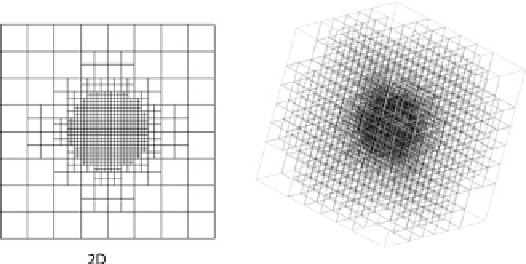Biomedical Engineering Reference
In-Depth Information
Fig. 21.3
Adaptively refined meshes with hanging nodes were used to discretize the problem
domain. Such meshes involve minimal computational penalty while refining and coarsening, and
the elements have a unit aspect ratio
Fig. 21.4
The problem geometry and the initial tumor seeding. The problem domain dimensions
are around 1000 µm
rise of a secondary stem cell population, some simulations consider an additional
concentration of cancer stem cells (
ρ
s
250 fg
/
µm
3
) located eccentrically with re-
spect to the primary cancer cell population. Based on the experimental observations
of change in tumor volume, the cell doubling times are assumed to be around one
day (
t
D
=
=
1
.
16 days,
t
s
D
=
1
.
04 days). The results presented here can be broadly
classified as follows:
•
Simulation of growth dynamics:
Initial simulations were geared towards repro-
ducing experimentally observed growth dynamics (evolution of tumor size and
shape, cell distribution within the tumor mass, etc.) (Mills et al.,
2011
,
2012
) and
were used to fine tune the various parameters controlling the species interactions
and the effects of mechanics on cell proliferation. Figure
21.5
shows the distri-
bution of various biological and chemical species after about 10 days of growth.
As discussed in the introduction, a secondary population of tumor stem cells was
also considered to study the effects of highly proliferating local cell populations
on the overall tumor growth. Our computations (Fig.
21.6
) show that the aggres-
sive proliferation of these stem cells would tend to ultimately dominate the shape
of the tumor, and depending on the relative proliferation rates of the two cell
populations, the resulting shape may be different from a spheroid or ellipsoid.









































